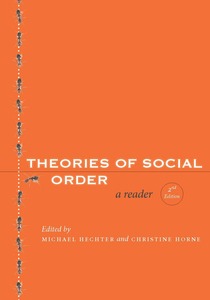Supplemental Readings
Hierarchies
Bowles, Samuel. and Herbert Gintis. 1976. Schooling in Capitalist America. Argues that American schools both reflect and legitimate existing economic structures, thereby maintaining inequality. Provides an empirical illustration of Marx’s argument.
Cooney, Mark. 1997. “From Warre to Tyranny: Lethal Conflict and the State.” American Sociological Review 62: 316-338. Explicitly tests Hobbes’ theory of order by describing data regarding the relation between state strength and numbers of violent deaths. Straightforward empirical application.
Foucault, Michel. 1977. Discipline and Punish: The Birth of the Prison. NY: Pantheon Books. Discusses the historical evolution of state-imposed sanctions.
Robert O’Harrow, Jr., No Place to Hide (2005), an authoritative and vivid account of the emergence of a “security-industrial complex” that seeks to monitor Americans’ consumption behavior for material — and potentially — political ends. Approaches Orwell’s telescreen technology, if not surpassing it.
Levi, Margaret, Of Rule and Revenue, California 1989.
Taylor, Michael. 1976. Anarchy and Cooperation. NY: Wiley. Argues that the state weakens community — thus weakening alternative sources of order and making itself more necessary.
Useem, Bert., and Jack A. Goldstone. 2002. "Forging Social Order and its Breakdown: Riot and Reform in US Prisons." American Sociological Review 67:499-525. An empirical study of the determinants of prison riots. Two cases of prison reform in the 1990s had widely divergent results. New Mexico privatized several prisons and these prisons were quickly beset by multiple riots. By contrast, New York's publicly run Rikers Island prison adopted reforms that quelled violence. A state-centered (cf. Hobbes) theory of social order explains both cases, showing how prison administrators and state and national governments can create the conditions under which social order breaks down or is restored. Since prisons do not permit exit however (unlike most countries) , this study may not be readily generalizable to most other kinds of social order.
Links
Campbell, Duncan, “Inside Echelon,” a description of the National Security Agency’s project to intercept and process international communications passing via communications satellites. It is one part of a global surveillance system that is now over 50 years old. Shades of Orwell’s 1984 (http://www.heise.de/bin/tp/issue/r4/dl-artikel2.cgi?artikelnr=6929&mode=html&x=8&y=8).
